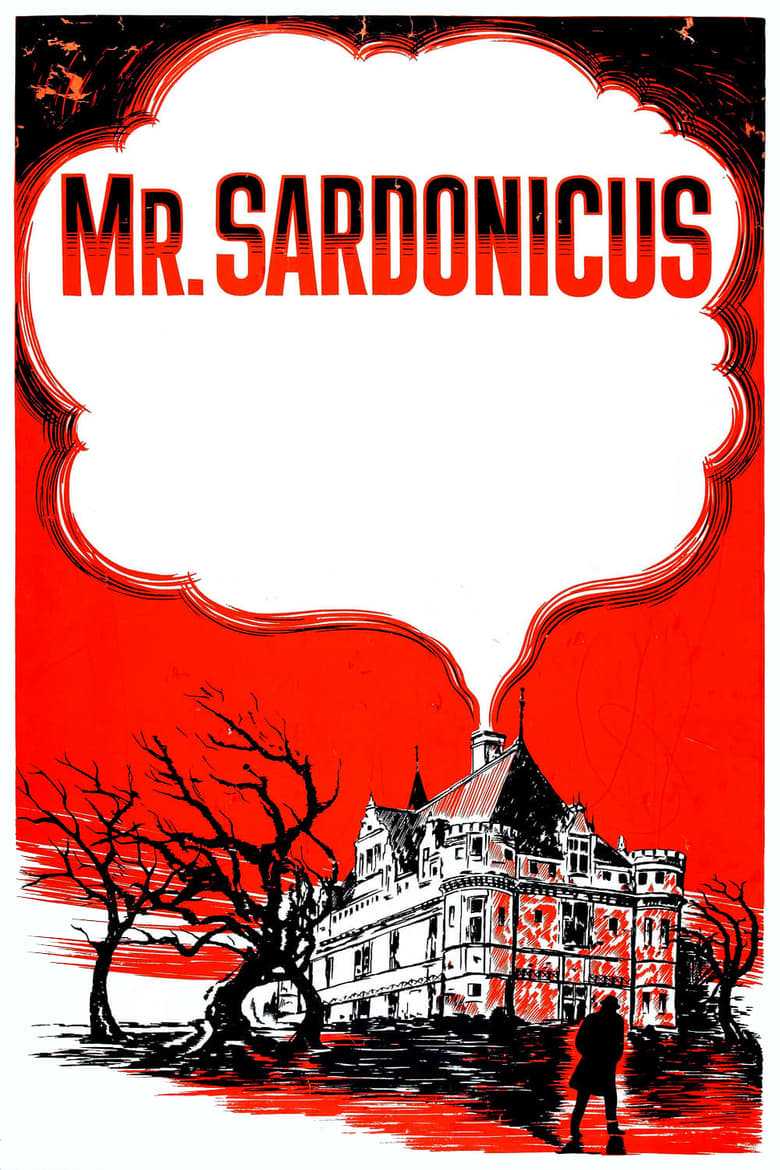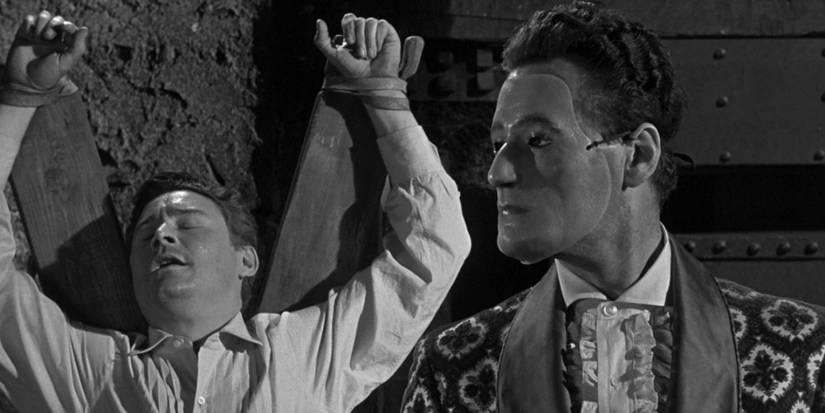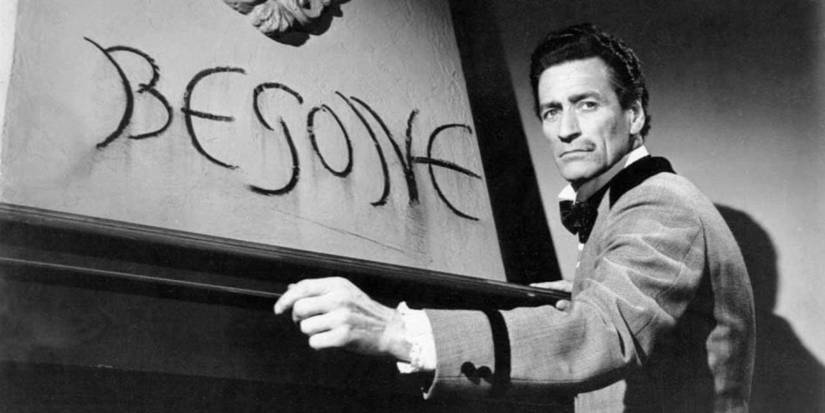Clue is an unlikely candidate for a theatrical return. Although the movie offers an interesting premise of multiple endings to try to draw viewers in more than once, it only brought in $14.6 million off its $15 million budget. This figure doesn’t even include marketing costs, which failed to clearly convey the film’s gimmick of multiple endings. Still, with a healthy sprinkling of pseudo-nostalgia and an enduring appreciation for actor Tim Curry, the movie gets a very much-deserved second shot at box office glory.
While Clue may have seemed innovative at its release, there is one director who beat the film to it by a healthy margin: the master of the gimmick, William Castle. Castle’s 1961 film, Mr. Sardonicus, employed alternate endings in theaters, based on votes from the audience. The result of leaving it to the will of the people, however, was not so straightforward, and ended up being one of the director’s most successful gimmicks.
‘Mr. Sardonicus’: A Weird Film From a Man Who Loved Gimmicks
Set in late 19th-century Europe, Mr. Sardonicus follows Sir Robert Cargrave, a respected physician called on by his past lover, Maude, to attend to her abusive husband, Baron Sardonicus. Sardonicus, who, after being overwhelmed with guilt after digging up his father’s grave to find a lottery ticket, has suffered from a grotesque facial deformity, causing a permanent twisted grin that he believes Cargrave can fix. After surgery, Sardonicus appeared to recover, but in truth, Cargrave gave him a placebo; upon learning this, the man’s grin came back.
From the plot alone, it is evident that Mr. Sardonicus was aiming for sensationalism to draw in viewers, before William Castle elevated interest further with a twist; viewers got to vote on whether Mr. Sardonicus would be forgiven and given a new life or punished for his poor moral judgment and left to rot. This would be one of many attention-grabbing ploys that Castle would use throughout his career to bring people into the theaters. The audience even included a young John Waters, who adored Castle and would bring his own gimmick to the screen with ‘Odorama’ cards handed out to those in attendance for Polyester, as a nod to the director’s legacy. Castle, who grew up at a time when movies aimed to break rules to engage the audience, such as the infamous Mom & Dad, carried on the roadside attraction approach to filmmaking, which is now forgotten.
This sensational means of drawing in audiences started in 1958 with the movie Macabre, which forced viewers to take out a (fake) $1,000 life policy to attend the screening with nurses on hand for those who fainted. This was followed by what is arguably his most well-known work, House on Haunted Hill (1959), which featured a skeleton on a string that would fly above the audience during one scene of the movie. A personal favorite, Homicidal (1961) featured a ‘fright-break,’ but if anyone left, they were put into “Coward’s Corner” to be ridiculed. Mr. Sardonicus‘ gimmick, however, was cruel in a whole other way.
‘Mr. Sardonicus’ Played a Cruel Joke on Audiences
At screenings of Mr. Sardonicus, audiences received ‘punishment poll’ cards with a thumbs up or thumbs down to vote on the villain’s fate. However, no matter what happened, the negative ending was always chosen, as audiences were believed to prefer seeing evil deeds punished over a happy ending. This meant that every screening ended with Baron Sardonicus, alone, mute and unable to move as his contorted face locked him into a dead-eyed state of horror, everyone abandoning him; how beautifully dramatic and bleak.
While there is a good chance that viewers may have opted for sweet revenge, the ‘bad’ ending was the only one that was ever shot, and the people’s votes did not matter at all. In Castle’s autobiography, Step Right Up! I’m Gonna Scare the Pants Off America, he made this clear, stating, “Only one ending was ever filmed, the one in which Mr. Sardonicus is punished.” This confirmation came after decades of speculation. While some may see this as a cruel trick, the truth is that for a whole generation of film fans, Castle defined what made the theater-going experience great, bringing a sense of magic (which also had the benefit of bringing in money for himself).
If viewers knew that the ‘Punishment Poll’ was in itself a placebo similar to the facial contortions experienced by the titular Mr. Sardonicus and cured by Sir Robert Cargrave, they may not have been so thrilled. William Castle took the alternate ending premise and made much more of a spectacle out of it, which thrilled fans instead of confusing them like Clue did. You can look at the trailer for the film, which highlights this process and does more than any marketing efforts Clue made to explain to its audience what they were going for with the alternate.
Should You Watch ‘Mr. Sardonicus?’
You have to love the campy horror films of the ’60s before even considering approaching this film. Yet, William Castle was not just about gimmicks, and his production does offer up a lovely macabre tale, Mr. Sardonicus being no exception. The movie is big and dramatic, reflective of the era of horror dominated by actors like Vincent Price, and the morality tale within is melodramatic yet engaging. At the same time, Castle’s films act as an adoring time capsule, in a day and age where the gimmick to get one into a theater is a popcorn bucket you have to pay extra for anyway.
Modern Hollywood could learn a thing or two about promotion through more gimmicky approaches; you know, short of pumping nauseous gas or “the smell of childbirth” into the theater, as Mom & Dad did to create a marketable panic. That aside, Mr. Sardonicus is an enjoyable macabre tale, but considering its history and audience participation, one can undoubtedly get lost in the film’s premise. Mr. Sardonicus is streaming for free on YouTube.

Mr. Sardonicus
- Release Date
-
October 8, 1961
- Runtime
-
90 minutes
- Writers
-
Ray Russell
-

Audrey Dalton
Maude Sardonicus
-

Ronald Lewis
Sir Robert Cargrave
-

Guy Rolfe
Baron Sardonicus
-

This story originally appeared on Movieweb




